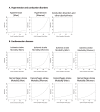Chronic diseases and conditions related to alcohol use
- PMID: 24881324
- PMCID: PMC3908707
Chronic diseases and conditions related to alcohol use
Abstract
Alcohol consumption is a risk factor for many chronic diseases and conditions. The average volume of alcohol consumed, consumption patterns, and quality of the alcoholic beverages consumed likely have a causal impact on the mortality and morbidity related to chronic diseases and conditions. Twenty-five chronic disease and condition codes in the International Classification of Disease (ICD)-10 are entirely attributable to alcohol, and alcohol plays a component-risk role in certain cancers, other tumors, neuropsychiatric conditions, and numerous cardiovascular and digestive diseases. Furthermore, alcohol has both beneficial and detrimental impacts on diabetes, ischemic stroke, and ischemic heart disease, depending on the overall volume of alcohol consumed, and, in the case of ischemic diseases, consumption patterns. However, limitations exist to the methods used to calculate the relative risks and alcohol-attributable fractions. Furthermore, new studies and confounders may lead to additional diseases being causally linked to alcohol consumption, or may disprove the relationship between alcohol consumption and certain diseases that currently are considered to be causally linked. These limitations do not affect the conclusion that alcohol consumption significantly contributes to the burden of chronic diseases and conditions globally, and that this burden should be a target for intervention.
Figures







References
-
- Balbão CEB, de Paola AAV, Fenelon G. Effects of alcohol on atrial fibrillation: Myths and truths. Therapeutic Advances in Cardiovascular Disease. 2009;3(1):53–63. - PubMed
-
- Ballenger JC, Post RM. Kindling as a model for alcohol withdrawal syndromes. British Journal of Psychiatry. 1978;133:1–14. - PubMed
-
- Barclay GA, Barvour J, Stewart S, et al. Adverse physical effects of alcohol misuse. Advances in Psychiatric Treatment. 2008;14:139–151.
Publication types
MeSH terms
LinkOut - more resources
Full Text Sources
Medical

